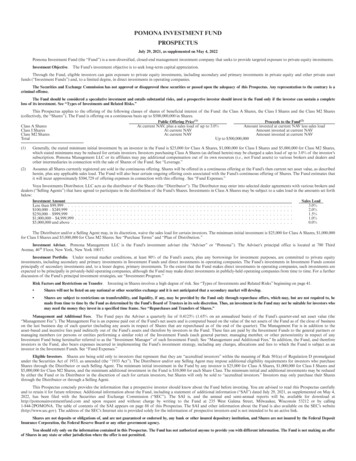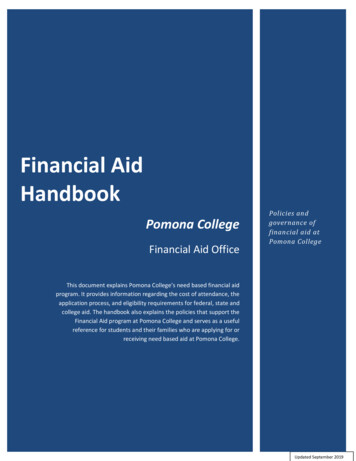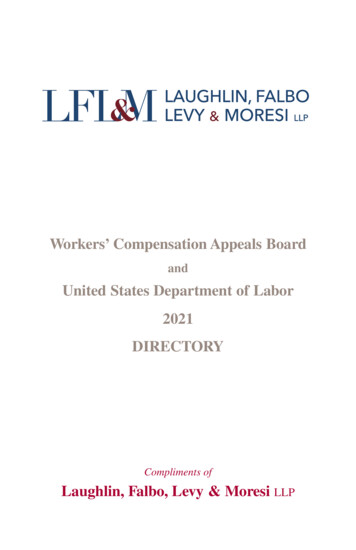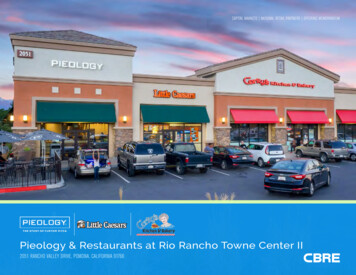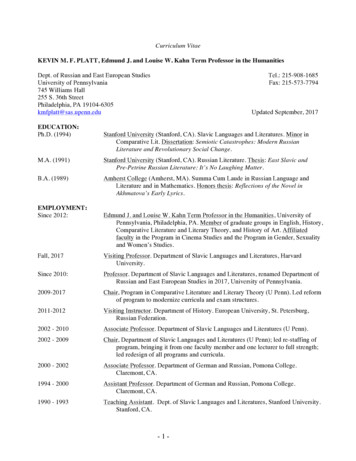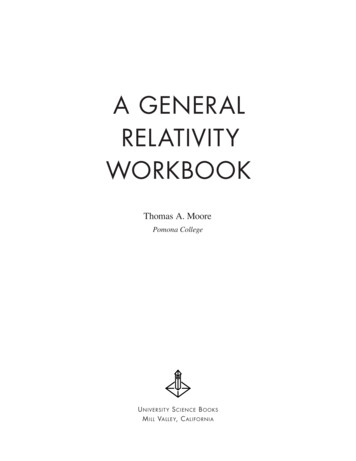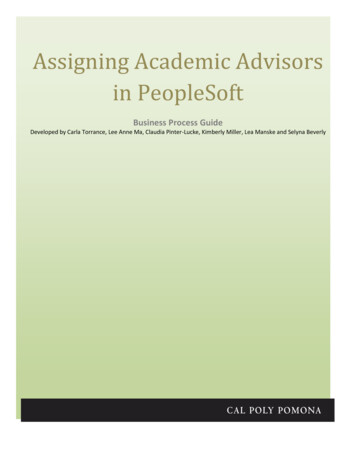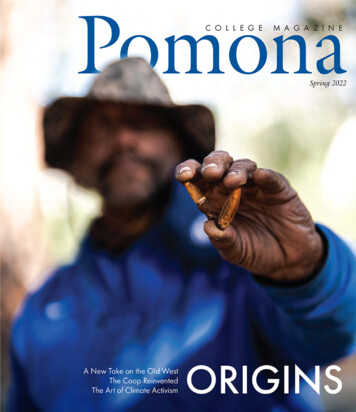
Transcription
PomonaC O L L E G EM A G A Z I N ESpring 2022A New Take on the Old WestThe Coop ReinventedThe Art of Climate ActivismORIGINS
HOMEPAGESpring 2022Pomona College Magazine1
2Spring 2022Pomona College Magazine3
STRAY THOUGHTSPomonaC O LL E G E M A G A Z I N ESpring 2022 VOLUME 58, NO 1ISSUE EDITORRobyn Norwood (robyn.norwood@pomona.edu)ART DIRECTOREric Melgosa (eric.melgosa@pomona.edu)BOOK EDITORLorraine Wu Harry ’97 (pcmbooks@pomona.edu)CLASS NOTES EDITORCatherine Gaugh (pcmnotes@pomona.edu)CONTRIBUTORSSneha Abraham (“A New Take on the Old West”) formerlyassociate director of news and strategic content at PomonaCollege and PCM book editor, was with the College formore than 16 years before recently accepting the position ofexecutive speechwriter at UCLA.The Night the Trees FellThe winds roared, the lights went out and the great trees came down, one after another.Ronald Nemo, Pomona’s longtime grounds and landscaping manager, was onthe scene by 6:30 a.m. after an unnerving Friday night in January brought the worstwindstorm to rip through Claremont and the region in many years.Nemo quickly shut off water flowing near Marston Quad after the lifted roots of fallentrees burst pipes. A once-towering eucalyptus lay across College Avenue. Stover Walk wascovered in a tangle of branches; Clark I had taken minor damage from a pine.In all, Pomona lost 17 trees, with hundreds more down across the city. Thenative coast live oaks, Pomona’s most prevalent tree, took the most losses on campus.Notable among the fallen were five oaks dating back to the early 1900s and now gonefrom along Stover Walk, where for decades they helped shade graduating seniors linedup for Commencement ceremonies. (The Wash, home to Pomona’s oldest oaks, waslargely unscathed.)Nemo, his crew and outside contractors called in to help set right to work oncleanup. He was grateful that nobody was injured, as he remembers the tragedyof 1998, when a eucalyptus fell on a car on College Avenue, killing two Pomonastudents. Nemo notes Pomona today has an extensive tree management program, witha regular cycle of inspections.The trees lost in the January storm amounted to a tiny fraction of the 4,000 orso on campus. But they were concentrated in familiar spots such as Marston, and thesudden change in the landscape stunned many Sagehens.Directing the cleanup along Stover, Nemo was philosophical regarding the plants:“The trees have a lifespan,” he says, “just like everything else.”They will find a new purpose. Some of the timber is going to sculptor andProfessor of Art Michael O’Malley, who recently taught a Critical Inquiry class, Treesand Wood. He too was on campus the morning after the windstorm.O’Malley notes that because of their age, the trees downed in the wind are asize that makes them rare. Most will be used in his Wood Sculpture course and, ifpossible, for a few benches for the campus. The hope, he says, is to find a way for thewood to be shared and celebrated by the community.What can’t be used for other purposes will become mulch to feed the landscape,according to Nemo.Replacement trees will be chosen with care, Nemo promises, with some campusplantings set for April 29, which is both Arbor Day and the first full day of AlumniWeekend 2022. Time will bring new trees and new memories.– Mark Kendall and Marilyn ThomsenFor more on the history of Pomona’s trees, see the 2014 PCM story“The Tale of the Trees” at ees.4Michael Waters ’20 (“Crossing Boundaries”) is a writerbased in Brooklyn whose work has appeared in The NewYorker and The Atlantic. He is currently working on TheOther Olympians, a book about 1930s trans athletes to bepublished by Farrar, Straus and Giroux.Carla Maria Guerrero ’06 (“Out of Pain, a Way to Help”)is a writer who lives in the Inland Empire with her husband,a toddler and two senior chihuahuas. After majoring in LatinAmerican Studies at Pomona, she returned to the College asassociate director of news and strategic content from 2015to 2021.ORIGINSCover: Ron Nemo, Pomona’s longtimegrounds and landscaping manager, holdingcoast live oak acorns. —Photo by Jeff HingFEATURESA New Take on the Old West 21Tom Lin ’18 challenges the mythology of the West with the tale ofa Chinese American laborer out for vengeance in The ThousandCrimes of Ming Tsu, winner of the Carnegie Medal for fiction.The Coop ReinventedCONTRIBUTING STAFFAlexa BlockLupe CastanedaLorraine Wu Harry ’97Jeff Hing, photographerKristopher Vargas, photographer26Lorraine Wu Harry ’97 returns to campus and delves into thehistory and continuing evolution of the Coop Fountain.SUBMISSIONS AND CHANGESFor class notes, address changes, photos and birth or deathnotices, email pcmnotes@pomona.edu or phone (909) 607-8129.For consideration for book publication notices, emailpcmbooks@pomona.edu. For other editorial matters or submissions,email pcm@pomona.edu or mail a letter to Pomona CollegeMagazine, 550 N. College Ave., Claremont, CA 91711. Magazinepolicies are available at pomona.edu/pcm-guidelines.POMONA COLLEGE MAGAZINEThe Art of Climate Activism 30GiGi Buddie ’23, a student of American Indian descent, traveledto COP26 in Glasgow after curating an exhibit of portraits ofIndigenous climate activists from around the world.is published three times a year. Copyright 2022 by Pomona College,550 North College Ave., Claremont, CA 91711.Crossing BoundariesPOMONA COLLEGEis an independent liberal arts college located in Claremont, California.Established in 1887, it is the founding member of The ClaremontColleges.34A trailblazer for the trans community, magazine publisherVirginia Prince ’35 left a complicated legacy.PRESIDENTG. Gabrielle StarrOut of Pain, a Way to Help 38CHIEF COMMUNICATIONS OFFICERMark KendallTrying to break mental health stigmas, Kasey Taylor ’15creates The Scooty Fund in memory of her brother.NON-DISCRIMINATION POLICYPomona College complies with all applicable state and federal civilrights laws prohibiting discrimination in education and the workplace.This policy of non-discrimination covers admission, access andservice in promotion, compensation, benefits and all other terms andconditions of employment at Pomona College.FSC MARKDEPARTMENTSHomepageStray ThoughtsLetter BoxPomonianaMilestonesBook TalkBookmarksHow ToTeamworkNew KnowledgeArtifactNotice BoardAlumni VoicesClass NotesIn MemoriamTime Spring 2022Pomona College Magazine5
POMONIANALETTER BOX‘Artifact’ Stirs Athletics MemoriesAs someone who practiced the gridiron arts on Merritt Field for several years—toilingbeneath the torrid San Gabriel Valley sun, stately oak tree, and watchful eye oflegendary coach Roger “RC” Caron—I greatly enjoyed the “A Drum Falls Silent” piecein the Fall/Winter 2021 edition. My mother and uncle, who were taken to the bonfirerallies during the 1950s by my grandfather, former Dean of Men Shelton Beatty,confirm that they were, indeed, a “huge tradition,” if a bit haphazardly staged—oneyear, the inferno almost toppled onto the fieldhouse that preceded the Rains Center.Speaking of the Rains Center, its walls and display cases are [of course] adorned with averitable cornucopia of similarly absorbing artifacts. I recall in particular the 1984 SummerOlympics posters strategically placed around the complex, along with the panoramicphotograph, across from the laundry room at the west entrance, depicting the scene atthe Los Angeles Coliseum during one of those 1920s Pomona-USC football games.I, for one, would not complain, if this “Artifact” item became a running feature,exploring a different Rains Center piece of memorabilia each issue!—Doug Meyer ’01Watertown, MassachusettsRenaissance PeopleReading the Fall/Winter 2021 issue ofPCM, I noticed diverse, contrasting interestsand pursuits of individual Sagehens.Among the Fulbright award recipients, I wasstruck by physics major Adam Dvorak ’21, whoplanned to conduct research in Denmark studyingthe effects of extreme weather events. Then comesthe 21st century Pomona Renaissance quality:“While in Denmark, Dvorak aims to teach violin.”Jarrett Walker ’84 is an international expert on thevital issue of public transportation, and a “Renaissanceman.” He was a math major at Pomona and has adrama, literature and humanities Ph.D. from Stanford.I also discovered some real human gems in theobituaries. Chalmers Smith ’51 practiced law inSan Jose while playing viola in the San Jose Symphonyand in string quartets. Elizabeth “Betty” KohlHendrickson ’60, a chemist, cared full-time for herthree children until they were in high school, published20 chemistry research papers with her husband, andlearned to play the hammered dulcimer at age 61.Julia “Judith” Moore ’66, Pomona magna cumlaude graduate, Peace Corps volunteer, graphicdesigner, Stanford MBA and a vice president inmarketing at Marriott, left the corporate world to focuson painting, exhibiting at galleries and a museum.We tend to occupy ourselves with big things, bigdreams, big bank accounts, great estates, statistics,information systems, huge data banks, numerousvehicles, mass production, globalization. If we canlocate what is small and of genuine interest andhigh quality and not just what is great or popularand famous, we can give the small the attention it isdue such that it flourishes, and everyone benefits.—Alan Lindgren ’86North Hollywood, CaliforniaFarewell to a PCM StorytellerPhoto by Rick Loomis/Los Angeles Times61943 AlumnusCherishes CalendarsToday I received my new calendar,The Pomona College Engagement Calendar.I graduated in the Class of ’43.Pomona has sent me seventy or more.I am guessing there were no calendarsIn the war years, ’44 and ’45.I think the development functionWas resumed in ’46.As a fund-raising techniqueIt has really worked with me.I never forget my alma materWhen I write my dates on the calendar.‘The Capacity to Ask Questions’Angela Davis, considered a radical in the1970s and now Distinguished ProfessorEmerita at UC Santa Cruz, returned to thePomona campus as the Ena H. ThompsonDistinguished Lecturer for two events inOctober. In 1975, Davis was appointed toteach in The Claremont Colleges’ BlackStudies Center only to be forced out after twosemesters by resistance from administrators,trustees and donors who objected to heractivism and notoriety as a former prisoner oncharges for which she was later acquitted.I do a month-at-a-timeOn one perfect page.I can see where I am goingAnd know where I have been.I have never lived in SouthernCalifornia since my college days,But I love the recollectionsOf life around the Quad.Angela Davis, left, at The Claremont Colleges in 1975-76, and during her October visit at right.I worked nights and weekendsIn Harwood for the girls.I ate my meals in FraryAlong with all the other boys.OA, Local VersionChemistry was learned with TysonAnd calculus with Jaeger.Basic botany with MunzWas an outstanding privilege.It’s hard to remember allThe names, but I’ll never forget,“Let only the eager, thoughtfulAnd reverent enter here.”It’s the calendars that haveProvided the yearly stimulationTo give back and to feelAnd express gratitude.Agustin Gurza, whose writing appeared in PCM for more than a dozen years, diedunexpectedly in January at 73. A former Los Angeles Times columnist and critic, Gurzawrote in the Times that “I can’t go anywhere without gathering stories, like lint on a coat.Stories about people helping out, moving up, fighting back.” Hisfirst piece for PCM, “El Espectador” in 2009, was about IgnacioLutero Lopez ’31, groundbreaking founder of a Spanish-languagenewspaper covering Pomona Valley barrio communities. Gurza’sfinal PCM story, “American Crossroads,” about UCLA ProfessorGenevieve Carpio ’05, appeared in our last issue. PCM’s editorsappreciated Gurza’s writing talents, his deep commitment totelling the stories of his subjects and his friendship from afar. Wesend condolences to his loved ones, including two siblings whoare alumni, Piti Gurza Witherow ’73 and Roberto Gurza ’80.2021–2022POMONA COLLEGEENGAGEMENT CALENDARIn a Q and A with The Student Life,Davis addressed the role of education inactivism.“The challenge, I think, is to guaranteethat students acquire the capacity to raisequestions. And as far as I’m concerned,that is the very heart of education, not onlyteaching students how to conduct researchand acquire information, but what we do withit. So it seems tome that the mostcrucial aspectof education isteaching andencouragingstudents how toconstantly engagein that processof questioning.And that involvesalso questioningthose things wetake for granted.”The traditional multi-day OrientationAdventures to such classic Californiadestinations as Yosemite National Park andvarious coastal spots for camping, surfing orkayaking have been on a pandemic hiatus. Butstudents arriving on campus for the first timehad opportunities to go on more localorientation experiences last fall, including arock-climbing day trip to Joshua Tree NationalPark, a dog-walking outing with four-leggedfriends from the Priceless Pets rescue group inChino Hills and a trip to Long Beach.Ella Novy-Marx ’25, left, and Brody Eggert ’25 playing with a dog.Protesting is part of the collegeexperience—even perhaps an essentialelement of a well-rounded education.But the small protest thatmaterialized outside of Frary Dining Hallone November morning was unexpectedto say the least. Several students, armedwith camp stoves and spatulas, werewhipping up made-to-order omelets foryawning students before class.Their cause? Weekday morningomelet service had been suspendedbecause of pandemic-related staffingissues. The students published a “DasOmelettistich Manifesto” with anapropos slogan: “You can’t make anomelette without breaking a few eggs.”Campus administrators said theomelet stations would resume as staffingallowed—and they did, with dailymade-to-order omelets returning to Fraryand Frank as indoor dining resumed forthe spring semester.Eli Li ’25 tries rock climbing at Joshua Tree National Park.—Lewis Perry ’43Oakland, CaliforniaEditor’s note: The PomonaCollege EngagementCalendar is sent out in latesummer to members of ourSagehen community. Alumni,families and friends ofPomona who have given to theAnnual Fund in the previousyear automatically receivethe calendar. The first yearthe calendar was published isunknown.Spring 2022John Haith works the re-opened Frary omelet station.Pomona College Magazine7
POMONIANA201020192011201220152013Each year, Art Professor LisaAnne Auerbach gives graduatingart majors something to take withthem as they leave Pomona.For more than a decade, she hasphotographed the department’s seniorsin individual portraits, capturing themin a setting they choose themselves oncampus or nearby. The resulting portraitsare colorful and sometimes playful, oftencapturing the students’ artistic sensibilities.“It’s an interesting time to make aportrait when most of our students areon the precipice of this new time in theirlives,” says Auerbach, who started theproject in 2010 during her first year atPomona. “The images reflect who theyare at the moment and maybe a bit ofwho they aspire to be, going forward.”Last fall, her work resulted in an exhibitin the Chan Gallery on campus: SeniorPortraits—The First Decade. Grouped byclass year, the individual portraits createda moving history of the departmentand subtle changes in student styles.Auerbach persisted with the projectthrough the pandemic graduations of2020 and 2021, driving as far as Ojai tophotograph a student,taking another photovia Zoom and creatingone with a photographof a photograph.With any luck, SeniorPortraits—The SecondDecade, is ahead.“It has a verypositive effect onSana Javeri Kadri ’16Instagram @sanajaverikadrithe relationship that I’m able to buildwith these students going forward,”Auerbach says. “We’re relating as peoplein the way that one relates to theirprofessors after they graduate, sowingthe groundwork for a future relationshipwhen we can be just people in the worldtogether—collaborators or friends.”Este Sanchez ’17Instagram @este ojoJacky Tran ’16Instagram @jackettrainThe Higghest BeamThe new athletics, recreationand wellness center adjacentto Bridges Auditorium toppedout with the raising of thehighest beam in November.Scheduled to open thisfall, the 99,925 square-footbuilding will feature not onlyfacilities for Pomona-PitzerAthletics but also a vastlyexpanded fitness area, plentifullocker rooms, three classrooms,two weight rooms and twolarge studios for activities suchas yoga or spinning.820162014Portrait of the Artist as a Young Grad“This is part of how wereinvent wellness on ourcampus,” says Miriam Merrill,director of athletics andprofessor of physical education,noting that wellness is acomponent of the College’s2020 Strategic Vision.Once it opens, visitors tothe athletics center may noticea small detail that gives ProjectManager Brian Faber pride.The room number of the firstfloor studio is a nod to Pomonalore: Studio 147.Spring 202220182017LegaciesDr. Martin Hyung-Il LeeBarbara Barnard Smith ’42Lee, the father of Pomona College Trustee Bobby Lee ’02and Jenny Lee ’07, immigrated to the U.S. from SouthKorea in 1974, becoming the first in his family tograduate college before going on to medical school withthe help of scholarships supplemented by student loans.As a doctor, Lee for decades served immigrants inLos Angeles’ Koreatown,sometimes even acceptingcopayments in windowsillchili peppers fromelderly widows withlimited incomes.Now students on Lee’ssame path to the Americandream will benefit froma 1 million gift toPomona College devotedentirely to scholarships.The Dr. Martin Hyung-IlLee ScholarshipFund is for studentsfacing financial hardships who come from immigrantfamilies, are first-generation college students and/or are pursuing careers in science or medicine.Lee’s son Bobby and daughter-in-law SophiaWhang established the fund to honor Dr.Lee, who died in 2021 at the age of 64.“My father lived the American dream, andthis is a way to carry on his memory and ideals,”says Bobby Lee, president and COO of LosAngeles-based JRK Property Holdings.Smith’s remarkable support for the College and nonWestern music continued at her passing last year atthe age of 101. She left more than 3.5 million to theMusic Department through a planned gift, bringing hersupport to the College over the years to 5.7 million.Half of her final gift will support the future renovationof Music Departmentfacilities and the namingof a space in honor ofthe late Professor ofMusic Katherine J.Hagedorn. Theother half willfurther endowthe existingBarbara B. Smith ’42Fund for Non-WesternMusic to supportethnomusicologycurriculum andother instruction,programming, equipment and performancesof non-Western music at the College. Smith’ssupport made possible Pomona’s non-Westernmusic ensembles, including the Balinesegamelan, West African and Afro-Cuban ensembles.After graduating from Pomona, Smith studied at theEastman School of Music at the University of Rochesterbefore embarking on a career teaching at the Universityof Hawaii at Mānoa from 1949 to 1982. Noting theuniversity’s diverse student body, Smith introduced classesin hula and Hawaiian chant, Korean dance, Chinesedulcimer and Japanese gagaku (court music). She foundedUH Mānoa’s ethnomusicology program and establishedits master’s and Ph.D. ethnomusicology degree programs.Pomona College Magazine9
MILESTONESA Winner of Prince William’sEarthshot PrizesGator Halpern ’12, who works to save the world’s coral forests, becameone of the inaugural recipients of the Earthshot Prize, a global awardfor groundbreaking solutions to environmental challenges. The honor,presented by Britain’s Prince William and the Royal Foundation,includes 1 million prize money as well as a professional and technicalnetwork to scale up environmental solutions to repair our planet.As president of the company Coral Vita, Halpern works with cofounder Sam Teicher from their base in the Bahamas to expand coralfarming and reef restoration efforts in the face of global warming. Bygrowing coral on land to replant in oceans, they work to give new lifeto dying ecosystems. The methods pioneered by Halpern and Teichergrow coral up to 50 times faster than traditional methods and improveresilience to climate change.Five Earthshot Prize winners were selected for the first year of theawards. Halpern’s Coral Vita received the prize in the Revive OurOceans category.Halpern previously was recognized as one of Forbes’ 30 Under 30Social Entrepreneurs for 2018, sharing the distinction with Teicher. Thetwo met while earning master’s degrees in environmental managementfrom the Yale School of Forestry and Environmental Studies, wherethey received Yale University’s first Green Innovation Fellowship.Marshall ScholarA Final Farewell for Pomona’s Ambassador of KabukiA memorial conference in honor of Leonard Pronko, a belovedmember of the Pomona College faculty for 57 years and one ofAmerica’s leading experts on kabuki, is planned for April 1-3.The weekend will feature an academic conference on Japanesetheatre and performance as well as three performances of kabukiin English on the Seaver Theatre mainstage. Both the conferenceand the production are open to the public free of charge. The fullystaged, English-language production of Gohiki Kanjinchō (GreatFavorite Subscription List), one ofkabuki’s most beloved plays,will be at 8 p.m. on April 1-2and at 2 p.m. on April 3.The weekend willconclude with a memorialservice and reception inhonor of Pronko at 10a.m. on April 3 before thefinal kabuki performancethat afternoon.The scholarly gathering—Tradition and Innovationin Japanese Theatre: AConference in Honorof Leonard C.Pronko—isplanned as a10hybrid event on Zoom and in person. It will feature presentationsof papers by international scholars, with special support for youngerscholars and graduate students in honor of the lifelong commitmentto mentoring students demonstrated by Pronko, who died in2019. In addition, the conference includes a special, live lecturedemonstration by members of the Fujima Kansuma Kai JapaneseDance Troupe.The conference is led by Carol Fisher Sorgenfrei ’69, a professoremerita of theatre at UCLA who studied under Pronko as anundergraduate, Pomona Professor of Theatre Thomas Leabhart andMark Diaz ’22, who was Pronko’s last kabuki student and will directand perform in the Seaver Theatre production.“Meeting Leonard and taking his classes literally changedmy life,” Sorgenfrei says. “Leonard was without doubt the mostbrilliant and charismatic teacher I ever studied with. Before takinghis class in Modern French Theatre, I knew nothing about Japaneseperformance, but he showed us how Japanese and other Asiantheatres had transformed modern French theatre. After that, Iwanted to learn everything I could about Japan.“This conference is a very small way that many of us whoadmired, loved and learned from Leonard can pass on his passions.I sincerely hope that future generations of Pomona students willcontinue to have opportunities to be inspired by Japanese theatre.There will never be another Leonard Pronko, but hopefully, hislegacy will live on.”For more information, call (909) 621-8186.Spring 2022The desire to bridge disciplinary divides and write about disease arewhat led Nina Potischman ’21 to apply for the prestigious MarshallScholarship, becoming Pomona’s latest recipient. She will spendtwo years in the United Kingdom pursuing graduate studies.An English major, Potischman knew she wanted to eventuallybecome a professor. But looking at American programs left hertorn. Should she pursue her interest in creative writing throughan MFA program or take the route of a Ph.D. in literary criticism?Looking at scholarships in the UK, she says she learned that thedisciplinary divide between creative and critical writing was moredistinctively American.“Because creative writing programs in the UK predominantlyemerged in the ’90s alongside the rise of theory, theory is moredirectly integrated into institutional practice. As a result, UK creativewriting programs are more interdisciplinary than their Americancounterparts, less bound by institutional orthodoxy, and moreopen to integrating critical and literary writing,” Potischman says.Potischman will spend her first year at University of Exeterand her second at University of Sussex and will build on herundergraduate research surrounding autoimmune illness.“When I was diagnosed with ulcerative colitis my sophomoreyear of college, I lost control of my body. Yet through writing—about my body, pain, taboo and food—I held onto my sense of self,”Potischman says.After being hospitalized multiple times for a severe flare of herillness, she decided to combine writing about her experiences withPomona College Magazineliterature focusing on autoimmunity. That work became her thesis,in which she explored how “chronic pain caused by an autoimmunedisorder reconfigures prevailing models of self and body.” With thescholarship, Potischman plans to convert her thesis into a book-lengthpiece of autotheory, a form of writing that combines autobiographyand prose with theory.11
BOOK TALKAfter the FloodA century has passed since the 1921 SanAntonio flood, a disaster that devastated thecity but also sparked a movement.With the coming release of the paperback edition ofEnvironmental Analysis and History Professor CharMiller’s 2021 book, West Side Rising: How San Antonio’s1921 Flood Devastated a City and Sparked a LatinoEnvironmental Justice Movement, PCM’s Sneha Abrahamtalked with Miller about what happened when thewaters receded—and the issues that remain morethan a hundred years later. The interview has beencondensed and edited for length and clarity.PCM: In relation to the 1921 SanAntonio flood, you examine spatialinequities, ethnic discrimination,environmental injustice. Howare those things revealed?Char Miller: One of the things that I’mreally fascinated with regarding this floodand hurricanes and other similar disastersis that these events are ephemeral. A floodcomes, it goes, and then it’s gone. A floodjust runs downriver until it heads into, inthis case, the Gulf of Mexico. But what itreveals are all of the social issues that maynot be talked about, but which are veryevident on the ground. For example, thespatial inequity in a place like San Antoniois evident if you ask a pretty simple question,“Who died, and where did they live? Andwho didn’t die, and where do they live?”And, in this case, you can, like anarchaeologist, do a very quick schematic.Those who lived in the flood plain tendedto be poor, tended to be Hispanic, but notexclusively, and tended to live in a landscapethat repeatedly flooded. It’s not just the1921 flood, there are floods dating back tothe 18th century when the Spanish arrived.Those who did not die even though theirstreets flooded tended to live in much moresubstantial homes that were designed towithstand periodic moderate flooding—almost invariably in all-white neighborhoods.12Then you start to look at thephysical geography. And it’s notjust that one group is in the floodplain; the other group is elevated.By 1921, the spatial differentialswere that in San Antonio thepeople who were dying or getting injuredor whose homes were getting destroyedtended to be black and brown, and thosewho didn’t tended to be white. So that’sone way to see it. If you look at the secondlayer, which is political inequity, that’s builtinto the system also. And so, althoughSpanish-surnamed residents and AfricanAmericans voted, they were voting for whitecandidates because that’s who dominatedthe political arena. So even if you had thepower of the vote, you didn’t have power.The third issue is economicinequities. Those who lived in victimizedneighborhoods were themselves manuallaborers and, therefore, had little-tono money to cushion themselves as aconsequence of one flood after another,after another, after another. And so, withthe ’21 flood, you can see that althoughthe downtown core got ravaged and theWest Side barrio got splintered, downtownrecovered and the West Side barrio didn’t.And those are post-flood examples ofpolitical disempowerment, of political andenvironmental injustice and the linkedspatial inequities. The city grieved for thosewho died and then immediately turnedits resources, its public funds, to supportand protect the downtown core, which itbelieved was the only economic activity andsocial life that mattered. The Anglo powerelite built a big dam and then straightenedout the river and did all sorts of workover the next decade, virtually none ofwhich was useful to anybody whose familyhad been destroyed in the 1921 flood.PCM: Similar to HurricaneKatrina in 2005 .Miller: Yes, totally right. Katrina,Hurricane Maria in Puerto Rico. Nameyour hurricane and they reveal that samekind of story. It’s dramatic in a sense, butalso predictable. And that’s the piece that,I think, drove me crazy while working onthe book, which is that there are reallytwo stories. One of which is the disasteras a disaster. The other is the repeateddisasters that go back to the 18th century.Even though I don’t talk about climatechange in the book, it’s actually an analog forwhat happened in San Antonio for decades.“We had a flood; let’s do something.”Spring 2022“Nah, let’s not.” “We had a flood; let’s dosomething.” “Nah, it’s too expensive.” Andthey kept delaying, calculating that in theshort term it’s cheaper not to do anything.In the long term, if people died, the elitecould say to themselves, well, they’re not ourbodies. They were other people who weregoing to bear that burden disproportionately.So that’s one part of the story.The other part of the story is that, yes,there was a disaster, and yes, it solidifiedfor a period of time the control of Anglodomination over the city’s budget, over itspolitics, over its social life, and managed toeven further segregate Sp
Pomona. COLLEGE MAGAZINE. Spring 2022. Pomona College Magazine. 1. HOMEPAGE. 2. Spring 2022 Pomona College Magazine 3. The Night the Trees Fell. The winds roared, the lights went out and the great trees came down, one after another. Ronald Nemo, Pomona's longtime grounds and landscaping manager, was on .

